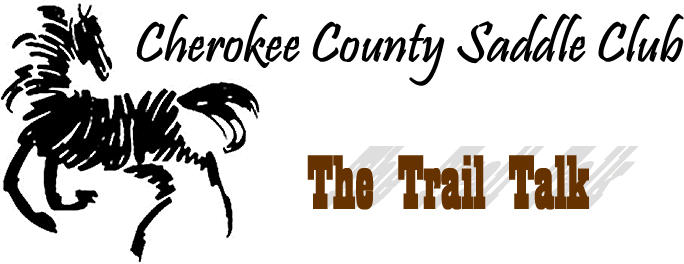 As
for all workdays, wear sturdy shoes or boots; bring work gloves,
lunch or energy snacks, and plenty of drinking water. The Southern
Off-Road Bicycle Association (SORBA) workdays have not been included
in this list. Please remember SAFETY as you work on any of the
trails.
As
for all workdays, wear sturdy shoes or boots; bring work gloves,
lunch or energy snacks, and plenty of drinking water. The Southern
Off-Road Bicycle Association (SORBA) workdays have not been included
in this list. Please remember SAFETY as you work on any of the
trails.
Location
Name |
Where is it? |
Horse Water |
Notes |
| Strawberry Mountain at dead end of FS 227
Fair |
About
2 miles beyond the GPT lot on gravel road FS 227 |
None |
Good
turnaround area at end of road, beside woods. Access to
GPT that is about ¼ mile away. |
| Dry
Creek area – across E. Armuchee Creek near FS 226
Good |
About
6.5 miles south of Villanow off East
Armuchee Road.
About
¼ mile from new equestrian parking lot. |
Stream
nearby |
Frequently
used for horse camping.
Can camp on either side of large creek.
About 4-6 spots available.
Access to GPT via gravel FS road. |
| Dry
Creek area beside FS 310 (multiple areas)
Good
to fair |
About
5.2 miles south of Villanow off of East
Armuchee Road |
Stream
nearby the best area. Another
is 200 yards from stream; another is ¼ mile. |
End
of FS 310 is at East Armuchee Creek and GPT.
Room for 2-3 rigs.
Additional
spots for 1 or 2 rigs along FS 310 further from the creek. |
| Horn Mountain by Gentry Gap on FS 233
Good |
The
FS 233 turnoff is about 3-4 miles south of Villanow on the
Pocket Road. |
Stream
nearby |
End
of FS 233 is at creek and campsite.
Room for 4-6 rigs.
GPT is couple hundred yards further up dirt extension
of FS 233. Frequently
used for horse camping. |
| Jacks
River Field
Good |
Beside
FS 64 in the Cohutta area, a few miles south of Watson Gap |
Stream
nearby |
Access
to the South Fork trail and loop.
South Fork trail connects to the GPT but not sure
if that part of GPT is open to horses. |
Useful
Horse Training Articles
Editor’s Comments
Most
of us are interested in articles about training our equine friends.
I personally favor the John Lyons concepts, but of course the
other modern trainers have variations that work fine also. One
can read books and magazines about training, or look at videos.
The purpose of this short article is to invite you to read the
training articles written by Jim Holland. Some of you know Jim
and know that he is an avid endurance rider. Jim was a trainer
for the IBM Corporation prior to his retirement, and he has used
his training experience to write informative horse training articles
that are easy to read, clear, and nicely illustrated with photographs.
Jim’s articles are slanted towards communication training
with your horse for activities that one encounters during endurance
rides. Things like proper leading, despooking, standing still
while mounting, going over obstacles, side passing, etc. They
are not about the physical conditioning required to get an endurance
horse ready for competition. Fortunately these are 99% the same
things we encounter in our trail rides and general horsemanship.
I have studied John Lyons materials, and I find Jim’s explanations
sometimes clearer to understand than John’s.
Jim’s
articles are available on his website at http://www.threecreeksarabians.com.
Click on the Training Articles button to view the articles. The
explanation of the articles in Jim’s words follows:
“These articles are written to help you train a horse mentally
for endurance and provide guidance on what will be expected of
your horse...and you...at an endurance ride. They do not provide
information on how to CONDITION your horse physically. Trail riders
and practitioners of other disciplines may also find the concepts
explained in the articles useful.”
Article
1 - Training Concepts and Basic Skills
Article 2 - Teaching Respect and Basic Ground Manners Under Lead
Article 3 - Advance Leading and Controlling Head Position
Article 4 - Teaching "Come to Me" with the "Conditioned
Response" Method
Article 5 - Teaching Demand "Come to Me"
Article 6 - Teaching the "Head Down" Cue From the Saddle
Article 7 - Being a "Rider" instead of a "Passenger"
Article 8 - Teaching Your Horse to be Handled
Article 9 - Teaching and Using the "Go Forward" Cue

 As
for all workdays, wear sturdy shoes or boots; bring work gloves,
lunch or energy snacks, and plenty of drinking water. The Southern
Off-Road Bicycle Association (SORBA) workdays have not been included
in this list. Please remember SAFETY as you work on any of the
trails.
As
for all workdays, wear sturdy shoes or boots; bring work gloves,
lunch or energy snacks, and plenty of drinking water. The Southern
Off-Road Bicycle Association (SORBA) workdays have not been included
in this list. Please remember SAFETY as you work on any of the
trails.